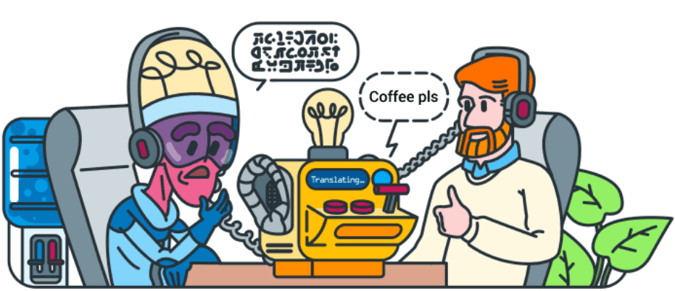More than any other time in human history, more people from diverse cultures now work together on the same tasks or in the same workplace. In terms of the advancement of humans, as a species, this is an amazing step forward. This means that managers and recruiters now focus more on talent and the ability to carry out anticipated tasks than the ability to communicate in the primary language used by the company.

However, with great power comes great responsibility (sorry, Spiderman!). While increased inclusion is good for the employees and the workforce, a language barrier can quickly build up and cause friction within your workforce.
In this blog we will discuss language barriers: the common types, how to fix language barriers in the workplace, and how Snapfix is helping reduce language barriers in facilities around the world. Let’s go!
What is a Language Barrier?
Communication Theory defines language barriers as those features of language utilization that cause miscomprehension or a total loss of meaning during communication. Language barriers encompass every aspect of language use, making it difficult for communicators to understand each other.
Language barriers are usually due to differences in cultural background, educational background, literacy level, and countries of origin. Research by Forbes and Rosetta Stone Business shows that 65% of executives admit that language barriers exist between managers and other employees. This combined research also indicated that language barriers lead to miscommunication, decreased productivity, difficult collaborations, and more.
Thanks to advancements in the technologies used for remote work and multi-organizational communication, it is common for workers from different countries, cultures, disabilities, and ethnicities to work together. The cultural collage that results from the extensive collection of multi-cultural talents is the leading cause of language barriers in the workplace.
Types of Language Barrier
Depending on who you ask, countless language barriers affect employees and managers in the workplace.
Below are a few of the prominent types of language barriers found in the workplace:

- Foreign Language
- Dialectal (Pidgin)
- Accents
- Slang
- Ambiguous Word Choices
- Literacy and Vocabulary Pool
- Poor Communication Skills
- Cultural
- Dyslexia
6 Ways of Overcoming Language Barriers in the Workplace
Every facility, hotel, warehouse, maintenance crew, hotel management, industrial plant, and other workplaces will encounter communication problems at one time or another. The question is, what should you do about it?
There are several ways to combat language barriers in the workplace.
Below are a few of the effective ones that we have tried ourselves. They all worked like a charm!
1. Setup Language Training Courses for Your Employees
An employee language training program is perhaps one of the most efficient ways of eliminating or reducing language barriers in the workplace. For instance, a US-based company with a significant presence in Italy should have its workers take an introductory Italian language training course. The goal is not to instantly make them fluent in any particular language that a course teaches; it is to ensure they understand the nuances associated with the language and its speakers.
2. Use Simple Language with Co-workers
While convoluted grammar and grandiose words are impressive on paper, they don’t do much to communicate ideas to an audience that doesn’t use those words daily. As a manager, you are better off using simple vocabulary and language that many of your employees and co-workers can easily understand.
Your standard operating procedure (SOP) can include a rule that ensures everyone communicates directly and simply when conveying work-related messages via any channel, including emails and newsletters.
Yes, Idioms should be avoided as much as possible, and if they must be used, they should be the ones that are quite popular, and anyone can easily deduce their meanings.
3. Discuss Cultural Differences
Language and culture are intrinsically intertwined. Most linguists would argue that it is impossible to separate culture and language as they are different sides of the same coin. It is rewarding to encourage employees and co-workers to explore each other’s cultural differences, like learning new phrases, meanings of idioms in other languages, foods, traditions, clothes, and more.
Exploring cultural differences among workers in the workplace makes it easier for people from different cultures to get along as they now understand where each person is coming from. Plus, it is always fun when people connect on a cultural level!

4. Employ Translation as a Communication Tool
For any organization, facility, hotel, or workplace with a diverse employee pool, translation is an effective communication tool in the workplace. This is because essential communication tools like training materials, written documents, safety guides, and signs can all be translated into languages that your culturally diverse employees would understand and assimilate without needing external assistance.
A language translator is also essential for your business, especially when dealing with top management roles where a leader speaks a different language and has to talk to a diverse group of employees at once. Plus, you don’t want any top-down information to be misconstrued.
5. Use a Buddy System
New employees with communication difficulties can be paired with a co-worker (buddy) who understands the facility intricately and can effectively communicate the job to the new employee. It is usually great if, in the case of a foreign language communication barrier, the buddies paired together both speak the same languages.
In cases where the buddies don’t speak the same languages, well-detailed demonstrations will do the trick. The key is to ensure that both parties understand each other well enough to communicate with non-verbal and verbal cues.
6. Use Visual Cues to Communicate
Last but not least on our list is the use of visual cues. We love the famous saying that says a “picture is worth a thousand words.” We genuinely believe that as many cultures have always found a way to unite and translate similar meanings from the same picture. This is why it is fundamentally important that you use as many visually descriptive cues as possible when communicating with employees and co-workers. Visual cues include everything from infographics to photos, diagrams, and signs. Anything that visually makes it easier to understand a task or situation is encouraged. Snapfix understands the power of pictures in communicating effectively at facilities, hotels, organizations, and factories worldwide. This is why our team designed Snapfix to take advantage of this communication tool.
Snapfix allows everyone on your team to report issues, by simply taking a photo or video. Tasks and Work Orders are prioritized, tagged for identification, and assigned to your team. Team members are alerted with a phone notification, and use instant messaging to collaborate and get it done efficiently. Your team and management have full visibility and accountability, with a full audit trail, dashboards and reports. Snapfix uses the universal RED YELLOW GREEN traffic light system to track tasks to completion to ensure nothing is ever missed.

How Snapfix Helps Managers Speak Over 6000 Languages
Snapfix is a platform that helps industries and facilities around the world to streamline their workflow and communicate more effectively using pictures and videos. Teams can create work orders, provide progress updates, complete forms, sign work completion forms, and more using Snapfix.
As of 2018, there were over 6,000 languages in the world, and the mere thought of that is mind-burgling. This is why Snapfix’s team created Snapfix to be simple to use and incredibly practical. If a picture is worth a thousand words, Snapfix uses pictures and videos to speak over 6,000 languages!
Many industry leaders worldwide already believe that Snapfix is fast becoming the global platform for getting things done worldwide. Snapfix makes it easy for multilingual teams to work in harmony while learning about their cultures and languages. Snapfix is also great for planned maintenance, asset management,NFC snaptagging, and more, for hotels and other facilities.
Get in touch with us to learn more about how we can help your team streamline its communication process and become more effective as a unit. Are you ready to dive right in? Get started with your free trial today!



